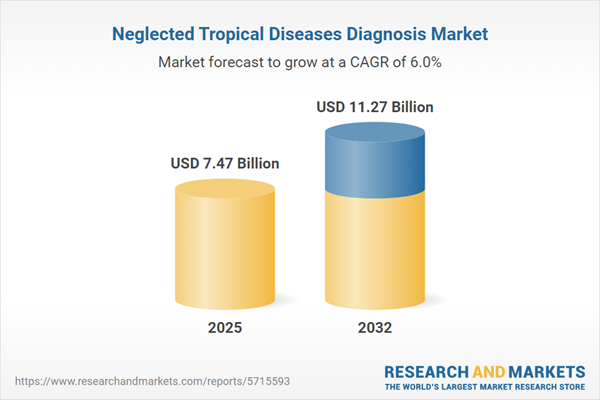Speak directly to the analyst to clarify any post sales queries you may have.
The Neglected Tropical Diseases Diagnosis Market is evolving rapidly as healthcare leaders prioritize fast, accurate diagnostics and scalable detection systems. For senior decision-makers, comprehensive market intelligence is essential to shape effective, resilient public health strategies in response to shifting global disease management needs.
Market Snapshot: Neglected Tropical Diseases Diagnosis Market Insights
The Neglected Tropical Diseases Diagnosis Market is experiencing steady growth, propelled by increased investment in public health and breakthroughs in diagnostic technologies. The expanding global health agenda compels organizations to implement agile disease surveillance and adapt to a continually evolving spectrum of both emerging and established conditions. This momentum encourages the adoption of sophisticated tracking solutions, enabling stakeholders to monitor infection trends with greater accuracy. As diagnostic reach extends, organizations focus on developing robust, regionally adaptive infrastructures, often through collaboration and strategic resource sharing. These efforts are fundamental to strengthening preparedness and response systems, ensuring effective mitigation of neglected tropical disease threats worldwide.
Scope & Segmentation of the Neglected Tropical Diseases Diagnosis Market
This report delivers an actionable, segmented overview of the Neglected Tropical Diseases Diagnosis Market, designed to help senior leaders allocate resources efficiently as disease profiles and healthcare priorities shift. Each segment addresses operational realities within diverse healthcare environments, providing clarity for informed decision-making.
- Technology: Immunoassays, chemiluminescence, enzyme-linked immunosorbent assays, fluorescence and light microscopy, molecular diagnostics, isothermal amplification, polymerase chain reaction, rapid diagnostic tests, antibody detection, and antigen detection enhance precision and streamline workflows in a variety of settings.
- Disease Type: Chagas disease, leishmaniasis, lymphatic filariasis, onchocerciasis, and schistosomiasis leverage tailored methods such as immunochromatographic assays and antibody-based techniques, incorporating diverse testing approaches for greater specificity in diagnosis.
- End User: Hospitals, research institutes, diagnostic laboratories, clinics, community health centers, and primary care providers ensure diagnostic accessibility from major metropolitan hubs to smaller rural communities through standardized detection protocols.
- Application: Laboratory confirmation, point-of-care diagnostics, community screening, surveillance initiatives, and post-elimination monitoring equip programs with adaptable responses to both endemic and post-endemic needs.
- Sample Type: Blood, plasma, stool, urine, biopsy, skin snip, whole blood, and tissue samples are compatible with centralized facilities and decentralized settings, supporting operational flexibility.
- Regional Coverage: The Americas, Europe, Middle East and Africa, and Asia-Pacific address region-specific infrastructure, compliance, and local adoption considerations to optimize technology selection and delivery.
- Key Players: F. Hoffmann-La Roche AG, Abbott Laboratories, Thermo Fisher Scientific Inc., Danaher Corporation, bioMérieux SA, QIAGEN GmbH, Becton, Dickinson and Company, Bio-Rad Laboratories Inc., Hologic Inc., and Coris BioConcept SA foster market innovation and competitive dynamics.
Key Takeaways for Senior Decision-Makers
- Innovative diagnostic platforms empower swift and accurate disease surveillance, supporting timely response at both local and broader system levels.
- Strategic partnerships between public agencies and private sector players accelerate the deployment and scalability of diagnostic technologies, enhancing operational effectiveness.
- Diversified and resilient supply networks, supported by improved sourcing strategies, maintain consistent diagnostic availability and reduce risks in complex markets.
- Integrating advanced analytics enables real-time insight, driving more agile management responses and supporting continual optimization of disease control measures.
- Proactive product development ensures regulatory compliance and adaptability, keeping organizations responsive to new standards in diagnostic delivery.
- Expanded access initiatives target underserved and remote communities, increasing healthcare equity and reinforcing system resilience across regions.
Tariff Impact: Navigating Supply Chain Evolution
Recent U.S. tariff changes on imported diagnostic reagents and assay components have led organizations to reconsider and adjust their supply chain models. Many are adopting supplier diversification, expanding domestic sourcing, and cultivating stronger procurement networks. These approaches are pivotal for sustaining diagnostic availability and supporting organizational adaptability in dynamic market and logistical environments.
Methodology & Data Sources
The analysis combines primary market research, expert interviews, review of scientific literature, and public health data evaluation. All findings are validated for accuracy and strategic alignment, ensuring relevance to the priorities of senior leaders active in infectious disease diagnostics.
Why This Report Matters
- Offers precise insights on technology integration and partnership development to strengthen diagnostic service planning and resource management.
- Assesses operational, compliance, and strategic variables needed to support market growth and sustain diagnostic programs in various healthcare systems.
- Provides benchmarking tools that promote best practices, support preparedness, and enable effective disease surveillance across diverse public health landscapes.
Conclusion
This report gives senior decision-makers targeted intelligence to advance diagnostic capabilities, reinforce disease management frameworks, and support collaborative approaches in the evolving global healthcare ecosystem.
Additional Product Information:
- Purchase of this report includes 1 year online access with quarterly updates.
- This report can be updated on request. Please contact our Customer Experience team using the Ask a Question widget on our website.
Table of Contents
3. Executive Summary
4. Market Overview
7. Cumulative Impact of Artificial Intelligence 2025
Companies Mentioned
The companies profiled in this Neglected Tropical Diseases Diagnosis market report include:- F. Hoffmann-La Roche AG
- Abbott Laboratories
- Thermo Fisher Scientific Inc.
- Danaher Corporation
- bioMérieux SA
- QIAGEN GmbH
- Becton, Dickinson and Company
- Bio-Rad Laboratories, Inc.
- Hologic, Inc.
- Coris BioConcept SA
Table Information
| Report Attribute | Details |
|---|---|
| No. of Pages | 183 |
| Published | November 2025 |
| Forecast Period | 2025 - 2032 |
| Estimated Market Value ( USD | $ 7.47 Billion |
| Forecasted Market Value ( USD | $ 11.27 Billion |
| Compound Annual Growth Rate | 6.0% |
| Regions Covered | Global |
| No. of Companies Mentioned | 11 |









